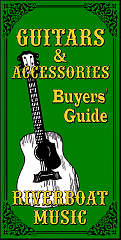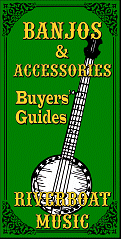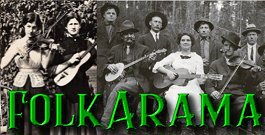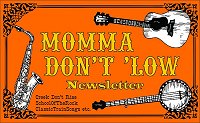
A Necessary Tool That Can Become a Crutch
| Please Read: How to Help Our Site at No Cost to You - Some of our articles contain recommendations for products we like and vendors we personally trust. Some of those vendors may pay us a very small commission if you click on a link and buy their products. This costs you nothing at all and helps offset the costs of what we do. So if we point you to something you decide to buy later, please make certain you come back through our site and click on the link directly. Thanks. |
| This Site is a Cookie-Free Zone - Except for discussion forums that you have to expressly register for, none of our pages use cookies of any kind. Some of the vendors we link to do, but that won't affect you unless you click on a link to their pages. Your continued use of this page indicates that you agree to our policy. For details, click here. |



|


About Capos
This is part of the "VERY Basic Guitar subset of our "How To Folk" articles. In an effort to "jump start" your enjoyment of Folk music and your ability to join in, no matter what instrument you play, we are providing some very basic notes about guitar chords.

 Note: - This series is part of the Folkarama page, which is dedicated to helping beginners "get into" Folk music and join Folk communities as easily as possible, with simple articles and links to resources that provide hands-on instruction in traditional acoustic instruments.
Note: - This series is part of the Folkarama page, which is dedicated to helping beginners "get into" Folk music and join Folk communities as easily as possible, with simple articles and links to resources that provide hands-on instruction in traditional acoustic instruments.
Folkarama, in turn, contains many references to more extensive articles and resources in Paul Race's CreekDontRise.com site, as well as other related pages.
What is a Capo?
A capo is any device that you attach to the neck of the guitar (or banjo, etc.) to raise the pitch of the strings. In almost every case, it presses down on all six strings at the same time, with enough pressure to fret them. Doing so essentially puts the guitar in another key, which is often helpful when the song is in a key that would otherwise be hard to play.Two of the most common types are shown below:
What Does a Capo Do?
 Acoustic guitar players find them most convenient when they need to play a familiar song in an unfamiliar key.
Acoustic guitar players find them most convenient when they need to play a familiar song in an unfamiliar key.
For example, I usually play "Fire and Rain" in D, but if someone needs to sing it in F, I can put a capo on the third fret and keep using the same chords, because it has essentially transposed everything up three half-steps - from D to F.
Similarly, an acoustic Blues guitar player used to playing his favorite Blues in E, might be asked to play in F or G. A capo will get him there and allow him to keep all his signature licks.
This works best if you're not dependent on chord sheets or sheet music in the new key. For example:
- You already know the song by heart,
- You understand chord progressions well enough to get along without chord charts or sheet music, or
- Any chord chart or sheet music you have shows you the chords you should play after you put on the capo (So the song is in, say, Bb, but it shows you putting the capo on the third fret and gives you the chords for G),
- You understand music theory and chord progressions well enough to transpose in your head on the fly. Believe it or not, if you play long enough, that should come to you, though I know guitar players who've played for decades and still can't do it. Not professionals, mind you . . . .
That's why chord sheets you download from the Internet often tell you where to put your capo. For example, if the song is in Eb, they will tell you to put your capo on the first fret and play in D. Then they'll show you the chords for D.
Piano/vocal sheet music, on the other hand, may just show the chords in Eb, which - for a three-chorder - would include Eb, Ab, and Bb7. Ouch.
All that said, best case is that you will eventually internalize the basic principles we've been discussing well enough to make the capo part of your tool kit, and not a crutch that fails you if you don't have the chords in front of you.
Tips for Playing Along with Capo Users - It helps if you know how much each fret position transposes the chords.
Say you're in a jam or sitting in with a friend and she slaps a capo on the second fret and starts playing a song that centers around the D chord. She's playing in E. How do you know that?
- She's playing the D chord and its "close friends" G and A7 a lot, albeit further up the neck.
- You know that two half-steps (frets) up from D is E.
If the song is a "three-chorder," you can either play in E, using E, A, and B7. Or you can follow her example and slap a capo on your instrument and play in D.
What if she slaps a capo on the fourth fret and starts using C, F, and G7 a lot? Chances are she's still playing in E, and you can follow along by playing the song in E. Or you could slap a capo on the second fret and play in D.
Here's a tip - if you're both playing guitars, the song will sound fuller if you're NOT both playing the same chords in the same position. So if she's playing C chords up four frets, and you can play the song in E without a capo, the overall sound will be richer.
"Nashville System" With a Capo - Nashville musicians often use a chord numbering system in which the key of the song is chord #1, and so on. So a "three-chorder" would label the chords 1, 4, and 5. Then they tell you you're playing in C. Okay, that's C, F, and G7. But the singer would rather sing it higher. So they shout out "Eb!" You can put a capo on the first fret and play D, G, and A7. Or you can put a capo on the third fret and use C, F, and G7.
Capos on 12-strings - In my childnood, when "steel-reinforced neck" meant only that a unadjustable hunk of steel was imbedded below the fret-board, it was common for 12-string owners to tune their guitars a step down and use a capo on the second fret most of the time they were playing with other folks. Tuning those old 12-strings (and many new ones) up to pitch put more pressure on the neck than they were designed to bear for long. If you see a 12-string owner who keeps his capo on the second fret almost all the time, be glad he has enough sense not to make the instrument's neck crazy and old before its time. (Side note, a friend once borrowed my 12-string, tuned it up to pitch, and barely avoided injury when the bridge snapped off and whipped up past his face. It was an old guitar and easily fixed, but what if it had been something else?)
Capos on Long-Neck Guitars - Similarly, I have a "long-neck" guitar that is made to be tuned a step down. Most of the time I use it, I keep a capo on the second fret so I can play the same chords as everybody else. (Why have it? Because when I want to use D chords to play a song in C, etc. there's nothing better. And a "dropped D tuning" when you're really in C kicks!)
I'm just sticking this and the 12-string examples in to let you know that not everybody who seems to have a capo permanently installed on the second fret of his guitar is "cheating" or ignorant.
When a Capo is a Crutch - If you're serious about acoustic guitar, you need to learn to play well in multiple keys. I would recommend at least C, G, and D (and you won't regret it if you learn to play in A and E). But I know folks who own guitars and play them frequently who can only play in one or two keys so they have to use the capo whenever they stray from those keys.
Most common are the folks who play in C by capoing up to the fifth fret and playing in G. When you capo past the third fret, you start approaching a point when your guitar sounds more like a mandolin than a guitar. If you have a bass player and don't mind losing some of the lower sounds of your guitar, fine.
But as a frequent soloist, I need those lower notes. If I need to play a song in C I'll play it in C. Or if I was "iffy" in C, I'd play it in A and capo up three frets. If I was "iffy" in both keys, I'd practice more.
I've even seen folks playing in D, or Eb by capoing on the seventh or eighth fret and playing in G. Their playing sounds like the mandolin break in "Maggie May." I shouldn't judge, I know . . . .
Why Folks Seldom Use Capos on Electric Guitar - Electric guitars are built differently from acoustics.
- Acoustic guitars get their volume and sustain from heavier strings, thin wood tops, and - when possible - open chords, but
- Electric guitars get their volume and sustain from electronics. They typically use thinner strings, so it's easier to play barre chords - chords where you lay your forefinger across all the strings and make up the rest of the chord with your other three fingers. Because barre chords on an electric guitar ring out longer than they do on an acoustic, there's not as big a drop in sound when you change chords, unless you want there to be.
Because of this extra sustain, open strings on an electric tend to sound bad unless they're used carefully.
In addition, because they're using barre chords (or maybe complex Jazz chords, which also use no open strings), electric guitar players can play in any key just by sliding the chords they're using up and down the neck. You learned that guitar part in Ab because that was on the record, but your singer wants it in A? Move your barre chords a fret toward the bridge. Or vice versa.
That said, if someone needs to play a rock riff that depends on open chords and they need to pitch the song higher, a capo may be the best solution. But you won't see that more than a few times in your life.
What Kind of Capo Should I Use? My first capo was a pen and a rubber band (don't laugh - I lived in the sticks and almost never got to a music store).
So when Dunlop started making elastic capos strong enough to work on the twelve-string that was my first "real guitar," I was in! Nothing else was available, so I grew up with elastic capos, and I still find them handy for several reasons (listed below). At this point, I have no trouble using them for 99% of the situations I find myself in.
That said, most guitar players today use some sort of clip-on capo like the "trigger capo" shown above. They feel like they can get it on and off more quickly. And since you can pop it straight on the fingerboard, it's less likely to stretch the strings sideways than an elastic capo.
If you only have one or two acoustic guitars, you can probably afford two clip-on capos. And if your guitars are vastly different guitar - say one is a 12-string - you'll need two different ones anyway. You don't want to show up to a gig, open mic, or jam and say, "Oh, I left my capo in my other guitar case; can I borrow yours?"
On the other hand, I've used elastic capos since the mid-1960s. I learned long ago that after you snap it across the strings, you raise it slightly so the strings straighten out, and then drop it down so the strings aren't stretched sideways. (And the truth is, both kinds of capos stretch the strings a little bit just by putting that extra pressure on them, so that is something you may have to deal with, regardless.)
For most folks the biggest disadvantages to elastic capos are:
- They eventually lose their strength, especially if you start out with the flimsiest ones, and
- Until you're used to them, they take longer to put on your guitar than the clip-on, clamp-on, or trigger capos.
To me, the advantages of elastic capos are:
- Lower cost - a big advantage if you have and use multiple guitars.
- You can store them on the strap, so you never have to stop between songs and reach around (or worse yet - go back to your case) to get your capo.
- You can store picks right on the capo.
- If I'm already capoing a song, and the song jumps up in key, I just have to slide the capo further along the neck.
- No one asks to borrow them because they assume they don't work or they're just for people who don't know any better.
True confession, I have and use multiple acoustic guitars. I have guitars I use for recording, guitars I use for performing, old-timey-looking guitars I use for historical reenactments, guitars I use for demonstrations, etc.
Whenever I accumulate a guitar I plan to use often, I set it up. Then I acquire a suitable gig bag, a $10 strap, an elastic capo, and a handful of flatpicks. I adjust the strap to the length I will need when playing that guitar, slide 2 or 3 flatpicks into the side of the capo that doesn't get stretched out, and snap the capo on the strap so it's in a comfortable position to reach in a hurry while I'm holding the guitar. Then when I'm done practicing on it, I leave it in the gig bag exactly like that, so I don't need to go searching for strap, capo, or picks if I grab that guitar the next time I head out.
Practice Capoing - The main thing about capos is not choosing which kind to use, but knowing when and how to use them. If you are constantly playing acoustic guitar with folks who like to play in F, Bb, or Eb, you'll learn how in a hurry. But it might do you some good to practice using a capo at home to play along with songs you know on your favorite music playback device. Say you love a song that's in Eb on the recording. Practice putting a capo on the first fret and playing in D. Or if it's in F or Bb on the recording, practice putting the capo on the third fret and playing in D or G, respectively. It doesn't even matter what kind of song it is, as long as you learn the hows and whens of using a capo effectively.
Best case - play the songs on your favorite playlist without looking at the keys, and practice moving the capo around and trying different chords until you figure out what key the song is in and what chords you would use to play it with your capo.
Conclusion
When I'm playing electric guitar, I have no trouble playing in keys like Ab. But I play acoustic guitar far more often. Since I jam and gig with a lot of different people playing a lot of different kinds of music, I often find myself playing a song I know in one key for a singer who performs it in another. If I know the song in D, and they want to play in C, no problem. But if they want to play in F, out comes the capo.One of my favorite Folk Revival tunes is Noel "Paul" Stookey's "Early in the Morning." Peter, Paul and Mary sang the song in Bb, but Yarrow and Stookey played it in G, capoed up to the third fret. They had to - the song has a full two-octave range, and Stookey didn't have the vocal range to start on D below middle C. With the capo on the third fret, the song goes from low F to high F, all notes Stookey could sing in a pinch. (As of August, 2023, there's a YouTube of them doing this live here. If it goes away, you should be able to find a similar performance online.)
And you have to admit that playing chords like G, C, Bm, Am, A, and D7 is a lot easier than playing chords Bb, Eb, Dm, Cm, F7, especially when the chords change very fast, as they do in that song.
Capo intelligently and responsibly, and you'll be able to play a lot of songs that would otherwise be in impossible keys. And as long as you're getting the right sounds of your guitar, don't let anyone - not even me - tell you that you're using your capo wrong.
Other Resources
Related resources include:- Meet Your Guitar - A brief introduction to the parts of the guitar and how to hold it.
- Three Magic Chords - A series of articles that get you started on basic chords you can use to play thousands of songs. Articles include:
- 3-Chord Songs in D - A list of songs you can easily play in D, using G and A7.
- What is a "Three-Chorder"? - The three-chord pattern that defines countless songs.
- More Useful Chords - "Next steps" to expand your range and enable you to play even more songs, including:
- C and C9 Chords - Once you've learned the "Three Magic Chords," the C chord will help you play thousands of 3-chord songs in G, but some folks find it cumbersome at first, so we've given you a "workaround" to use while you're getting used to it.
- It's All Relative - Am and Em - The fingerings and most common uses of guitar's easiest minor chords, Am and Em. We also sneak in Am7, Em7, and Bm7 to expand your chord vocabulary.
- A Major - the Fiddler's Friend - Expand your chord arsenal with A major and its BFF, E7.
Other resources will be listed as I get to them.
- 3-Chord Songs in G - A list of songs you can easily play in G using G, C9 (or C) and D7.
- The Circle of Fifths - a deeper discussion of the relationships among chords, something that helps musicians quickly learn or follow new songs, or even transpose them to other keys. (This is on our sister site, CreekDontRise.com)
Sister Sites
 Other sites we started to keep this site from getting too big to be useful include:
Other sites we started to keep this site from getting too big to be useful include:
- CreekDontRise.com is a repository of articles about Folk music and the instruments on which it has been traditionally played.
The "Acoustic" page includes a long list of articles including maintenance and playing tips on all sorts of traditional acoustic instruments.
 RiverboatMusic.com is a buyers' guide for acoustic and traditional instrument from a musician's point of view, focusing on the uses, reliability, and practicality of various instruments, and not just the marketing hype about the shape of the fret markers or whatever.
RiverboatMusic.com is a buyers' guide for acoustic and traditional instrument from a musician's point of view, focusing on the uses, reliability, and practicality of various instruments, and not just the marketing hype about the shape of the fret markers or whatever.
For instruments like dulcimers that have mostly small manufacturers or cheap imports, we try to tell you what to look for, irrespective of brand.
 Momma Don't 'Low includes a free e-mail newsletter that discusses all of those topics above and more. We plan to include other features as time permits.
Momma Don't 'Low includes a free e-mail newsletter that discusses all of those topics above and more. We plan to include other features as time permits.
Note - If you wish to sign up for our newsletter and ask a question at the same time, please click on the Momma Don't 'Low newsletter button to learn more and to get a link to our signup form.
 PaulRaceMusic.com is the "landing page" for Paul's own musical endeavors, plus many memoirs and blogs about music and the music business.
PaulRaceMusic.com is the "landing page" for Paul's own musical endeavors, plus many memoirs and blogs about music and the music business.
 ClassicTrainSongs.com describes railroad songs that every train lover should know. Or at least know about.
ClassicTrainSongs.com describes railroad songs that every train lover should know. Or at least know about.
- SchoolOfTheRock.com has articles about Christian music, Christian music careers and performance, Christian living in general, and vintage saxophones, another of Paul's interests. This site has separate newsletters, etc., by the way - there isn't a lot of overlap with the Momma Don't 'Low(tm) newsletters.
For information about other music collections and projects, check the links at the bottom of this page.
 Whatever else you get out of our pages, I hope you come away with some great ideas for "sharing the joy."
Whatever else you get out of our pages, I hope you come away with some great ideas for "sharing the joy."
And please stay in touch!
All material, illustrations, and content of this web site is copyrighted (c) 2001, 2002, 2003, 2004, 2005, 2006,
2007, 2008, 2009, 2010, 2011, 2012, 2013, 2014, 2015, 2016, 2017, 2018, 2019, 2020, 2021, 2022, 2023 by Paul D. Race. All rights reserved.
Creek Dont' RiseTM is a participant in the Amazon Services LLC Associates Program, an affiliate advertising
program designed to provide a means for sites to earn advertising fees by advertising and linking to Amazon.com.
For questions, comments, suggestions, trouble reports, etc. about this page or this site, please contact us.
| Visit related pages and affiliated sites: | |||||
| - Music - | |||||

|
 |
 |

|

|

|

|

|

|

|

|

|

|

|

|

|

|

|
| - Trains and Hobbies - | |||||
 |

|

|  |
 |

|
| - Christmas Memories and Collectibles - | |||||
 |

|
 |

|
 |

|
| - Family Activities and Crafts - | |||||
 |

|

|

|

|

|



